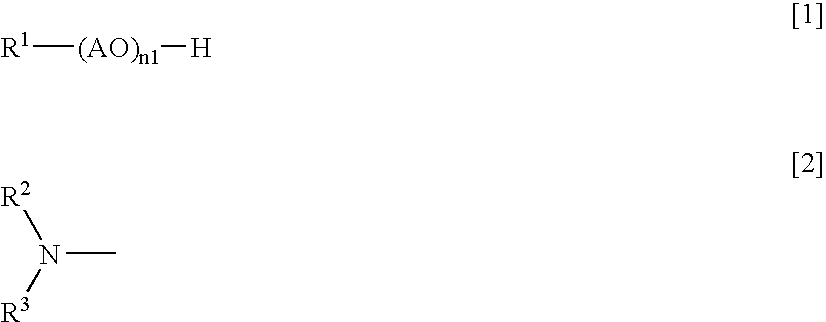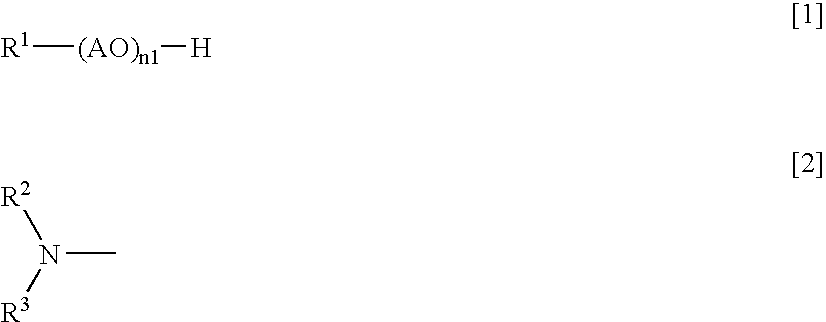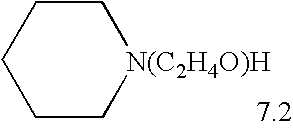Cement additive
a cement additive and additive technology, applied in the field of cement additives, can solve the problems of low working efficiency and difficulty in sufficiently preventing slump loss, and achieve the effects of preventing slump loss, improving work efficiency and ease of execution on the working site, and high fluidity
- Summary
- Abstract
- Description
- Claims
- Application Information
AI Technical Summary
Benefits of technology
Problems solved by technology
Method used
Image
Examples
synthetic example 1
[0071] 5-liter pressurized reactor was charged with 64 grams of methanol and 2.0 grams of sodium methoxide as a catalyst and the air was replaced with nitrogen gas. 2904 grams of ethylene oxide was then gradually supplied into the reactor at a gauge pressure of 0.05 to 0.5 MPa to perform addition reaction at a temperature of 100 to 120° C. The reactor was cooled to 50° C. after the reaction was terminated. After 112 grams of potassium hydroxide was supplied into the reactor and the air was replaced with nitrogen gas, 153 grams of allyl chloride was gradually added to the reaction mixture while stirring at 80° C. The reaction mixture was stirred for 6 hours until the reaction is terminated and then neutralized with hydrochloric acid. The resulting salt was removed as a byproduct to obtain the polyoxyalkylene compound represented by the formula (4) and shown in table 1.
[0072] 1524 grams (1 mole) of the above synthesized compound (4), 107.8 grams (1.1 mole) of maleic anhydride and 300...
synthetic example 2
[0073] The polyoxyalkylene compound shown in table 1 was synthesized according to the same procedure as the synthetic example 1. 2052 grams (1 mole) of the polyoxyalkylene compound and 117.6 grams (1.2 mole) of maleic anhydride were weight and charged in a 5-liter flask equipped with a mixer, thermometer and a tube for introducing nitrogen gas. 14.0 grams of benzoyl peroxide as an initiator was added to the mixture in batch at a temperature of 50° C. or lower to perform polymerization at 85±2° C. for 5 hours to obtain a copolymer “b”. The copolymer “b” had a weight average molecular weight of 23700 and a kinetic viscosity of 527 mm2 / s at 100° C.
synthetic example 3
[0074] The polyoxyalkylene compound shown in table 1 was synthesized according to the same procedure as the synthetic example 1. 1024 grams (2 mole) of the polyoxyalkylene compound, 196 grams (2 mole) of maleic anhydride, and 300 grams of toluene were weighed and charged into the reactor same as the synthetic example 1. 12.1 grams of benzoyl peroxide as initiator was dissolved in 300 grams of toluene and dropped into the mixture under nitrogen atmosphere for copolymerization. Toluene was then removed to obtain a copolymer “c”. The copolymer “c” had a weight average molecular weight of 21400 and a kinetic viscosity of 254 mm2 / s at 100° C.
PUM
| Property | Measurement | Unit |
|---|---|---|
| Mass | aaaaa | aaaaa |
| Fraction | aaaaa | aaaaa |
| Fraction | aaaaa | aaaaa |
Abstract
Description
Claims
Application Information
 Login to View More
Login to View More - R&D
- Intellectual Property
- Life Sciences
- Materials
- Tech Scout
- Unparalleled Data Quality
- Higher Quality Content
- 60% Fewer Hallucinations
Browse by: Latest US Patents, China's latest patents, Technical Efficacy Thesaurus, Application Domain, Technology Topic, Popular Technical Reports.
© 2025 PatSnap. All rights reserved.Legal|Privacy policy|Modern Slavery Act Transparency Statement|Sitemap|About US| Contact US: help@patsnap.com



